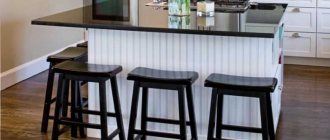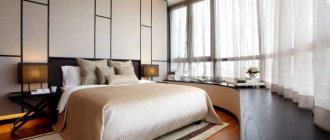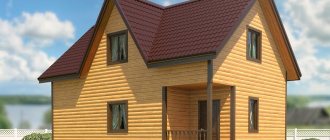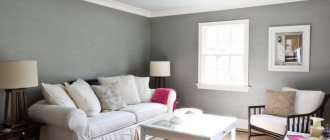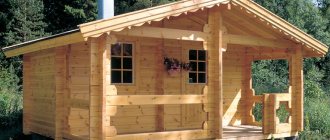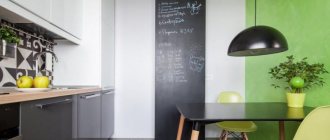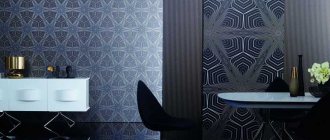Ceiling spot lamps are directional spotlights that allow you to independently adjust the direction of the light. Some of them resemble ordinary spotlights, sconces or chandeliers, but their design is very different from other types of lighting fixtures. A special feature of the spots is the presence of a movable bracket, which is used to change the direction of lighting. Spot lamps differ in types, designs and methods of use in the interior.
Advantages and disadvantages of ceiling spots
Ceiling spots in the interior have many advantages, the main one of which is the ability to redirect the flow of light at any time. It is worth noting other advantages of using such lighting fixtures in the interior. These include:
- Easy to install. They are installed as easily as conventional spotlights. You can install them yourself, without having any special education or special tools.
- Visual expansion of space. Stylish lamps do not clutter up the space, and the lighting from them is no worse than from classic chandeliers.
- There is no need to lay grooves. The advantages of ceiling spots also include the ability to install them anywhere in the suspended ceiling. You don't have to lay grooves for this. It is enough to make a small hole in the ceiling through which to connect the lamp with a rigid wire.
- Versatility. Can be used for suspended ceilings and suspended structures. They are perfect for any design direction. A wide selection of rotating spots of various shapes, colors and designs will allow you to choose the optimal design in each specific case.
Other advantages of rotating spots include the ability to connect them in groups, which are controlled by separate switches.
Despite the obvious advantages of ceiling spots, they also have a number of disadvantages. These include:
- Difficulties in organizing general lighting. Using ceiling spots, it is more difficult to organize lighting, which can be achieved using a hanging classic chandelier.
- Higher cost. To obtain the required level of lighting, several lighting fixtures must be used at once, which makes their installation more expensive.
However, with the correct organization of lighting and the choice of high-quality spots, you can solve all problems with lighting in a room of any size.
The difference between spotlights
If a classic chandelier, located in the center of the ceiling, evenly illuminates the entire space, then spots act differently. Small lamps create a light spot, and thanks to the possibility of point installation and a special bracket that allows you to rotate the lamp, it is directed in the desired direction.
In this way, you can illuminate a small space using spot lamps as additional decorative light, or even abandon the chandelier and central lighting as such in favor of ceiling spots. With proper calculation of the required lamp power and the number of lamps, spot lighting can be no less bright than, for example, a crystal chandelier.
Ceiling spots have one huge advantage over classic lighting fixtures: the mood and image of a room can be changed in a matter of minutes by changing the lighting.
- Spots can be turned on and off one at a time or in groups;
- Adjust the brightness of lighting;
- Change the position of the lamps, and therefore the direction and nature of the lighting.
Thus, in any room you can create an atmosphere that completely matches your mood and plans. Turn a brightly lit living room into a party room or a cozy room for friendly gatherings. And a spacious and bright kitchen, where it is convenient to cook, into an intimate tea chill-out with a pleasant twilight.
Along the perimeter of the kitchen there are ceiling spots on rails, and in the center there are ordinary lamps
The kitchen area is illuminated using built-in ceiling spots, photo
Ceiling spots on rails go well with classic lamps in the kitchen
Ceiling spotlights are used in the kitchen for decorative lighting
An example of lighting with overhead ceiling spotlights in a spacious living room
The large space is illuminated by built-in ceiling spots along with lamps and chandeliers
Lighting in the living room is made using ceiling mounted spotlights
Types and features
There are three main types of spots, which differ in design and installation method. These include overhead rotating, built-in and complexly combined structures.
Built-in
Built-in structures are known to many as adjustable spotlights. In this case, the direction of the light can be slightly changed. Built-in spot spots are used to illuminate small functional areas. To achieve uniform illumination, you can slightly adjust the light flow.
The dimensions of the spot devices are small, and installation requires only making a small hole in the suspended ceiling. Ceiling recessed luminaires are installed using spring clamps.
Invoices
Overhead rotary structures differ from built-in lamps only in the installation method. According to the installation method, they most closely resemble sconces. A special bracket is used to secure them. It is attached to the ceiling, and a lamp is attached to it using screws.
Their advantage is that there is no need to cut a hole in the ceiling. This will allow you to change designs to others at any time.
Complexly combined
The devices differ from spot ones only in that one housing can contain several light sources that can be directed independently. Such designs are most similar to chandeliers. Their main advantage is the ability to effectively illuminate all rooms and direct streams of light even to remote corners of the room.
In addition to the above types, spots are divided according to the shape of the base. There are spots on a bar, as well as designs on a square, round or flat base.
What is a spot?
It’s not for nothing that the word “spot” is quite unusual to understand, because it has English roots, and translated means “spot”. That is, a small point in the ceiling, or maybe in the wall, that gives light. Thanks to spots, you can illuminate specific parts of the room or objects in it.
The spot is designed in such a way that it has a lamp and a bracket with a rotating mechanism. Brackets for lamps can be round, arc-shaped or square. Thanks to such a bracket, ceiling spots can be rotated in any direction. Some models are equipped with a dimmer that can adjust the brightness of the light.
Types of lamps for ceiling spots
Wall-ceiling spots can be equipped with various types of lighting elements. Depending on this indicator, the properties of the equipment differ.
Incandescent lamps
While classic chandeliers still use incandescent lamps, most modern lighting fixtures use energy-saving lighting elements. In addition, the use of incandescent lamps in spots is not recommended for a number of reasons:
- Spots with light bulbs require a reflector that will reflect both light and heat. In addition, hanging spots are most often made of plastic, which is damaged by constant heating. In this case, it is recommended to use glass structures, the cost of which is higher.
- Modern technologies are aimed at maximum energy efficiency, so diode spots are most often produced, which allow you to get even lighting and save energy.
- Incandescent lamps have a warm light. To create certain design options, the ability to vary shades is important, and incandescent lamps do not provide this opportunity.
- The heat generated by incandescent lamps can damage some surfaces. For example, it is prohibited to use such lamps for suspended ceilings. With prolonged contact, they can damage even plastic structures.
Halogen lamps
Such lighting elements visually resemble classic incandescent lamps, but their characteristics are much better than conventional lamps. Their light is much brighter and is not inferior to the sun. In addition, their use makes it possible to highlight certain interior objects.
Halogen lamps are durable, energy efficient and have a high brightness rating. However, due to the fact that such light bulbs also heat up, it is prohibited to use them for suspended ceilings.
LEDs
LED lamp is the most modern and energy-efficient type of lighting elements. This is why ceiling LED spots are most often used. There are many options for diode spots. A single LED or many small elements can be installed.
Directional LED light is more suitable for illuminating a specific decorative item, but it is preferable to use multiple elements for general lighting of the room.
Diode spots are economical, reliable and durable. LED lighting elements do not heat up, so they can be used for suspended ceilings. You can buy lamps with white and yellow light, as well as different brightnesses. In addition, you can use a brightness adjustment system, so it is possible not only to direct the light through the use of suspended structures with LED lighting, but also to adjust its brightness.
Spot connection systems
Fastening technologies for different spots differ, but the general principles of installation are similar.
Installation of ceiling spots consists of several stages :
- Before installing the ceiling structure, a wire is laid from the junction box to the lighting fixture.
- The connection is made in parallel: from the connection device to the first device, and then to subsequent ones.
- When installing an electrical cable, it is worth taking its quantity with a margin of 26-35 cm. The excess wire will then be hidden under the ceiling structure.
- After the ceilings are installed, the fixtures are installed.
Modern spots require the presence of step-down transformers that are connected to each device.
When choosing lamps, you need to take into account the size of the product and the dimensions of the room. The choice of option is influenced by the height of the ceilings. The installation site must be freely accessible.
Interior use
Depending on the purpose, you can purchase street spots and structures for decorating residential and office premises. The ability to direct lighting allows the use of lower power lamps. In this case, you can focus the light on certain interior details or diffuse it throughout the room.
Modern spotlights easily replace classic chandeliers and can be used indoors or outdoors. They are used to decorate various rooms.
Bedroom
To decorate the bedroom, you can use crystal and metal spots, as well as structures with glass. In this case, you can independently set the direction of the light. For example, you can illuminate only the bed or dressing table. If you install spots around the perimeter of the room, you can get even, diffused light.
Cabinet
Spots can be used to beautifully illuminate bookshelves or a desk. Unlike the classic type of lighting, spots make it possible to direct the light. Can be used in combination with floor lamps or table lamps. The office can use white or black design options, square or round designs, as well as ceiling wooden spots or crystal lighting fixtures.
Living room
To decorate a room in a high-tech style, you can use spots separately or in combination with main lighting. In this case, you can turn off the main light and leave suspended ceiling spots to illuminate the sofa, table or other interior elements. To decorate the living room, you can use loft spots, lamps with crystal, as well as original black and white spots in the high-tech style. In addition, when using LED elements, they can be used for suspended ceilings and suspended structures.
Kitchen
A stylish high-tech kitchen will be transformed if you use kitchen spotlights for lighting. Most often, double designs are used to distribute light onto the work surface and table. Spots for the kitchen can be plastic, glass, metal and crystal. In this case, both white and bright colors with a variety of patterns and ornaments are used.
Street
Street spots are used to illuminate the area near the house. They have great power and range of luminescence, and will also help in creating decorative effects when lighting a certain area of the yard. Street lamps are made of glass and metal in white, black, gray and other colors. They allow you to adjust the direction of light and also have protection from the negative effects of precipitation, so street spots are the best option for lighting your personal plot.
Spots are used to illuminate the kitchen, bedroom, study, offices and garden plots. They are distinguished by ease of installation, practicality and versatility, and a wide range of models will allow each person to choose a ceiling spot that suits the design and has the optimal configuration.
Selection of spots by light bulb type
The intensity and nature of the light depends on what type of light bulb is used in the spot. All types of light bulbs are well known to us. Let's talk about what is good and what is bad about each of them for a spotlight:
- Incandescent lamps are the most affordable. The list of advantages is limited to this, although it is for this reason that they remain in demand. They can be used in complexly combined and tensioned spots, sometimes in overhead ones, but not in built-in ones. Strong heating of the light bulb can damage the suspended or suspended ceiling.
- Halogen lamps are the same as incandescent lamps. More economical, have a longer service life... And the same disadvantages as their closest relative.
- Fluorescent or energy-saving lamps. They save energy, shine brightly and last a long time. They hardly heat up during operation, which means they can be used everywhere. They do not turn on at full power right away, sometimes their light seems inappropriately cold, they hum during operation and create problems with disposal.
- LED lamps - nothing better has been invented today. They save energy better than their predecessors, they last the longest, and are safe because they hardly heat up. Eco-friendly - do not contain harmful substances like fluorescent ones. Somewhat more expensive than its competitors, but with such an impressive list of advantages, the high cost more than pays off.
- It is advisable to use filament lamps if you want them to also perform a decorative function, that is, in an open type spot.
Which light bulbs you use in the spots is your choice.

